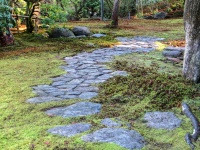Familia: Dicranaceae → Genus: Dicranum → Species: Dicranum howellii
Genus name: Dicranum • シッポゴケ属 • shippo goke (literally: tail moss)
Dicranum mosses are called wind-blown mosses or fork mosses. These mosses form densely packed clumps. Dicranum is distributed globally, with different species (about 90 total) endemic to different parts of the world.
There are 70+ different dicranum species (including varieties) growing in Japan, but not Dicranum howelii, which is endemic only to west coast of North America.

Dicranum howellii • 1/1//2017
Description: Dicranum howellii is an acrocarpous (having an upright growth habit) plant, which grows in open to crowded clumps of erect shoots, shiny, green or green with yellow tones. Stems are 2-8 cm tall and rhizoids pale to russet.
Leaves range from curved and pointing to one side of the stem to straight and upright, occasionally curled and twisted a little, lance-shaped, not wavy, the leaf tip acute.
Habitat: Decaying wood, humus, soil, occasionally bogs.

SJG • 3/26/16 – bright clumps of Dicranum on the corner of Area Z (above and L of grate)
Distribution: Howell’s dicranum moss occurs only in the northwestern part of North America; endemic in AK, BC, WA, CA, ID and MT. There are 11 species of Dicranum in WA state, the neighboring WA Park Arboretum has also Dicranum tauricum.
SJG notes:
• Dicranum howellii in Seattle Japanese Garden grows in rather small clumps; usually appearing as a distinctive bright green spot among other mosses on the ground or near the tree stumps.

SJG • 3/26/16 – Dicranum in Z upclose
Color is not a good indicator for identifying mosses, but in winter, spring and late fall Dicranum howellii is easily spotted around SJG because of its unusual glossy green appearance, comparing to other mosses: if you look at it closer at and find it ‘fury’ or ‘hairy’ you are probably looking at Dicranum howellii. In summer it takes yellowish tint and it’s much harder to spot.

1/1/17: Dicranum scoparium (L) and howellii (R)
So far it’s the only species of dicranum found in our Garden, but check the picture of potted D. howellii (from our garden) side by side with D. scoparium (sample form elsewhere) to see how green our SJG’s D. howellii is.
Polish genus name: widłoząb
__________________________
References & Related Reading:
• Montana Field Guide shows not only classification but also has a description plus habitat information, distribution & a discussion about reproduction.
• iNaturalist.org has a good description of Dicranum howellii and a comparison to Dicranum scoparium.
• The Flora of North America has a description as well as a very nice distribution map and an illustration of Dicranum howellii.
• To learn about molecular biology and genetics of Dicranum genus go to BioOne.org.
• Literary reference: ‘Gathering moss, A Natural and Cultural History of Mosses‘ by Robin Wall Kimmerer has a chapter called ‘Sexual Asymmetry and the Satellite Sister’ about dicranum: a fascinating story about the sharp difference between size of Dicranum males and females, resulting in avoiding competition and favoring specialization instead, for the survival of the species and for the benefit of the moss-babies. In a compelling way Kimmerer wrote about resulting de facto matriarchy among Dicranum species, where females dominate all aspects of life and where the spores come to life without a gender, capable of becoming and living its life as a male or a female, solely determined by where the spore lands: if it drifts on an unoccupied space it will grow to be a new full-size female, but if it’s blown into a patch of same species Dicranum, it will get trapped there to develop as a captive, dwarf male.
• Commercial uses: Note sure why, but Dicranum moss (regardless of species) is often called a ‘mood moss’ by florists, terrarium builders and others who encounter moss in a non-scientific, but otherwise intimate manner. The site Commercial Moss Harvest in PNW doesn’t mention Dicranum but has interesting info about moss harvesting.


Congratulations on starting this moss blog!!
LikeLike